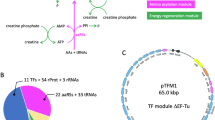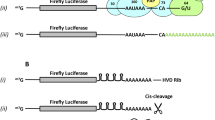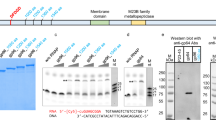Abstract
ENZYMATIC activities for synthesising four ribohomopolymers, including poly(G), have been found in rat liver, and all are stimulated by RNA1,2. Recently two poly(G) polymerases were isolated from plant cells; one requires poly(G) as a primer3 and the other denatured DNA4. We report here the isolation of an enzyme from Ehrlich ascites tumour, which catalyses the incorporation of GMP from GTP into an acid-insoluble product. This enzyme requires specific tRNAs as primers. Our data suggest that the tRNAs which can serve as primers are specific to tumours or tissues infected with tumour viruses.
This is a preview of subscription content, access via your institution
Access options
Subscribe to this journal
Receive 51 print issues and online access
$199.00 per year
only $3.90 per issue
Buy this article
- Purchase on Springer Link
- Instant access to full article PDF
Prices may be subject to local taxes which are calculated during checkout
Similar content being viewed by others
References
Wilkie, N. M., and Smellie, R. M. S., Biochem. J., 109, 485–494 (1968).
Niessing, J., and Sekeris, C. E., Nature new Biol., 243, 9–12 (1973).
Burkard, G., and Keller, E. B., Proc. natn. Acad. Sci. U.S.A., 71, 389–393 (1974).
Fukasawa, H., and Mizuochi, T., Biochem. biophys. Res. Commun., 58, 405–411 (1974).
Haruna, I., Ohno, T., Hozumi, N., and Watanabe, I., Gann. Mono. Cancer Res., 12, 203–211 (1972).
Pearson, R. L., Weiss, J. F., and Kelmers, A. D., Biochim. biophys. Acta, 228, 770–774 (1971).
Nishimura, S., in Methods in Nucleic Acid Research (edit. by Ishihama, A., Okazaki, R., Kyogoku, Y., and Nishimura, S.), 251–258 (Kyoritsu Shuppan, Tokyo, 1972).
Yamada, Y., and Ishikura, H., FEBS Lett., 29, 231–234 (1973).
Nishimura, S., in Procedures in Nucleic Acid Research (edit. by Cantoni, G. L., and Davies, D. R.), 2, 542–564 (Harper and Row, New York, Evanston, San Francisco, London, 1971).
Mikoshiba, K., Tsukada, Y., Haruna, I., and Watanabe, I., Mature, 249, 445–448 (1974).
Haruna, I., Spiegelman, S., Proc. natn. Acad. Sci. U.S.A., 54, 579–587 (1965).
Haruna, T., Ohno, T., Watanabe, I., and Ikawa, Y., Proc. Japan Acad, 46, 1016–1021 (1970).
Ohno, T., and Haruna, I., in Methods in Nucleic Acid Research (edit. by Ishihama, A., Okazaki, R., Kyogoku, Y., and Nishimura, S.), 165–168 (Kyoritsu Shuppan, Tokyo, 1972).
Author information
Authors and Affiliations
Rights and permissions
About this article
Cite this article
ITOH, T., HARUNA, I. & WATANABE, I. Incorporation of GMP into specific tRNA molecules by extracts of Ehrlich ascites tumour cells. Nature 257, 327–329 (1975). https://doi.org/10.1038/257327a0
Received:
Accepted:
Published:
Issue Date:
DOI: https://doi.org/10.1038/257327a0
This article is cited by
Comments
By submitting a comment you agree to abide by our Terms and Community Guidelines. If you find something abusive or that does not comply with our terms or guidelines please flag it as inappropriate.



